Lab-to-Lab: US-Russian Lab-to-Lab Collaboration Story [Archived]
- Home
- Joint Verification Experiment
- Science Collaboration
- Nuclear Materials
- Nuclear Weapons
- Nuclear Experts
- What’s New
After the end of the Soviet Union, downsizing of the Russian nuclear complex presented the challenges of defense conversion and maintaining a decent living standard of the uniquely skilled specialists. The primary concern of the US government in this situation was potential proliferation dangers of brain drain out of the former Soviet countries. The US nuclear lab scientists, however, developed a broader view of the post-Soviet people-related challenge of the Russian nuclear complex. Based on the close working relations they enjoyed with the Russian counterparts, they understood that the challenge was not so much how to prevent potential brain drain but rather how to ensure the safety and security of Russia’s nuclear assets by helping to provide stability in the Russian nuclear institutes and their closed cities.
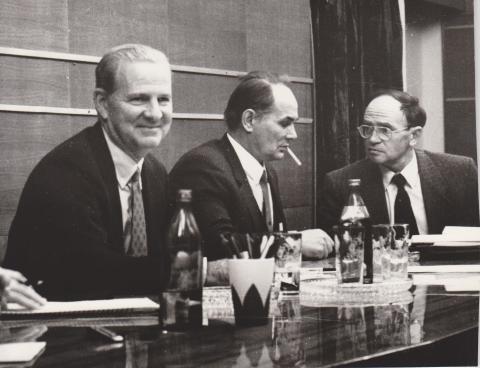
The proposal to establish the ISTC was made during the meeting of U.S. Secretary of State James Baker with Viktor N. Mikhailov in Snezhinsk on February 14, 1992. James Baker (left), Viktor Mikhailov (center) and Evgeny Avrorin (right).
Motivated to prevent brain drain from the Russian nuclear complex, the US government implemented several people-oriented programs. The International Science and Technology Center (ISTC) program began operations in March 1994 under the management of the US State Department. The ISTC was created to provide multilateral, peer-to-peer engagement on cooperative scientific research; it was funded by a number of countries, led by the United States. The objective of the ISTC was to provide weapons scientists with short term contract-based employment that would allow them to be integrated into the broader international scientific community.
The Initiatives for Proliferation Prevention (IPP) program was established in 1994 as the Industrial Partnership Program (same acronym) and managed by the DOE to link American companies in the United States Industry Coalition (USIC) to former Soviet weapons institutes, with the Department of Energy (DOE) national laboratories acting as intermediaries. IPP attempted to establish commercially viable opportunities that would lead to sustainable employment of the scientists.
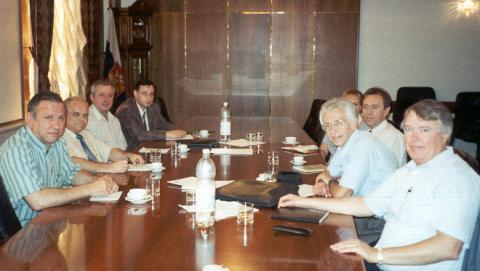
Defense Conversion Study working group meeting in Minatom 1999. James Toevs, Sig Hecker and interpreter Andrey Fadeev (on the right) face Alexander Antonov, the lead for the study on the Minatom side, and other Minatom colleagues.
The Nuclear Cities Initiative (NCI) was created in 1998 by an agreement between DOE and Minatom and was designed to provide civilian, non-weapons-related employment opportunities for former weapons scientists. Like the IPP and ISTC projects, NCI sought to support and enhance non-weapons-related expertise by developing entrepreneurial skills among nuclear weapons workers and hoped to assist in creating the conditions necessary for economic development and conversion in the nuclear cities.
The NCI and IPP programs were combined into the Russian Transition Initiative in 2002 and into the Global Initiative for Proliferation Prevention in 2006. Contrary to the position of the Russian scientific community, Russia terminated its participation in ISTC in 2015.
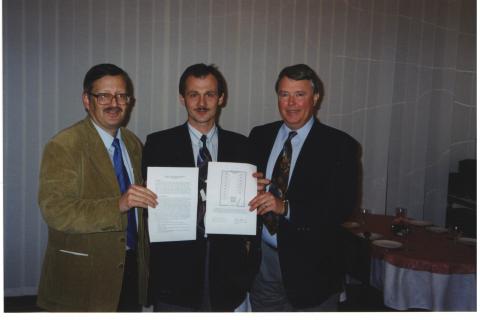
Alexey Golubev (center) displaying Open Computer Center documentation with Dale Nielsen of LLNL (left) and Jim Toevs of LANL (right) in Sarov, 1999. Pictured are the two pages of the report that Nielsen and Toevs prepared for US Dept. of Commerce to verify that 16 IBM computers had been removed from the classified areas of VNIIEF. This opened the door for the establishment of the Open Computing Center, the first NCI project in Sarov.
The lab-to-lab relationships provided the main channel for conversion efforts under these programs. ISTC was regarded both by Russian and international scientists as a highly efficient program beneficial to all sides involved. Over 60 thousand Russian scientists were involved in international collaboration under ISTC. Some estimates indicated that roughly 17,000 former Soviet scientists participated in the IPP programs from 1994 to 2008. Overall, the cooperative conversion efforts may not have created many civilian jobs, but they were successful in helping to ameliorate the difficult financial plight of the Russian nuclear workers, providing friendship and hope during difficult times, and introducing Russian specialists to western companies and to western project and business management practices that served them well in subsequent years.
In the words of participants
I liked the ISTC process by which scientists devised an idea, put together a team, and then got approved for direct financing because it helped breed independent, self-reliant scientists. It was also an ideal situation for a scientist wanting to start a technical project because it helped them avoid the normal intermediate bureaucratic steps. The ISTC also funded scientists to attend international conferences, exposing them to other specialists working on these subjects. I felt this expanded their intellectual horizon and helped them see their place in the world. The ISTC was very important in creating independent scientists with leadership capabilities.
Lev D. Ryabev, Deputy Rosatom Minister for Nuclear Weapons Complex (retired)
Much was at stake in the transition to a stable Russia. The safety and security of nuclear weapons were dominant concerns, which in turn relied on maintaining essential people and institutions in Russia. The DOE’s nuclear weapons laboratories responded to the call and challenge to make a difference in the national interest. The IPP and programs like it, originated by these laboratories, served a valuable role in establishing unprecedented understanding and effective relations with their counterparts in Russia. It may turn to be a rare moment in history, but hopefully it was one element in getting the world through a very precarious time. The dedicated effort and commitment of those involved was exceptional. We are pleased to have been a part of it.
Hugh Casey, Molly Cernicek, LANL and Thomas O. Hunter, SNL
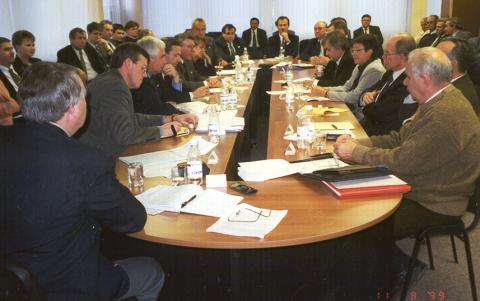
Motorola team meets with VNIIEF leadership to discuss business opportunities. Second and third on the left are Jim Prendergast, head of the Motorola Physical Sciences Research Laboratory and Bill Wiggenhorn, President of Motorola University. First person on the right is Ivan Sofronov, head of the VNIIEF Mathematics and Computational Science Division. Also in view on the right are Rady Ilkaev, Vladimir Rogachev and, at he far end of the table, Alexei Golubev. Sarov, 1999.
Find it in the book
Joint efforts in defense conversion and job creation are described in vivid and often dramatic detail in Chapter 7 of Volume II by Evgeny N. Avrorin (VNIITF), Vladimir G. Rogachev (VNIIEF), Boris K. Vodolaga and Anatoly S. Ivanov (VNIITF), Yuri K. Zavalishin (Avangard Plant), Alexey V. Golubev (Sarov), Hugh Casey, Molly Cernicek (LANL), and Thomas O. Hunter (SNL), James W. Toevs and Siegfried S. Hecker (LANL), Ann C. Heywood and James E. Trebes (LLNL), Vladimir I. Zhigalov and Dmitry Yu. Faikov (Sarov).
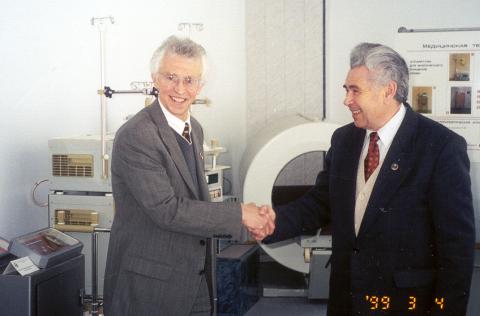
Hecker and Director of Avangard Plant Yuri K. Zavalishin in the Avangard Business Center showcasing medical instruments being produced by Avangard’s conversion program. Sarov,1999
Documents
Agreement establishing an International Science and Technology Center (ISTC). November 27, 1992
